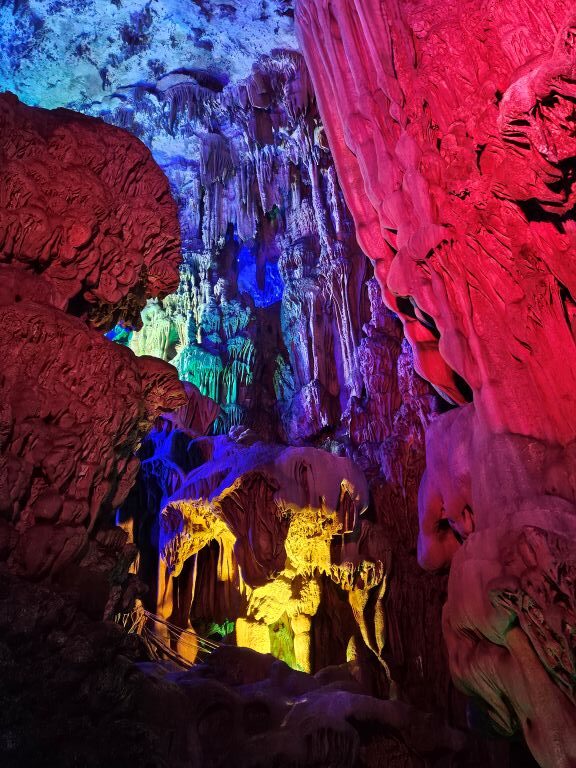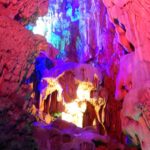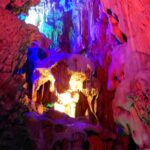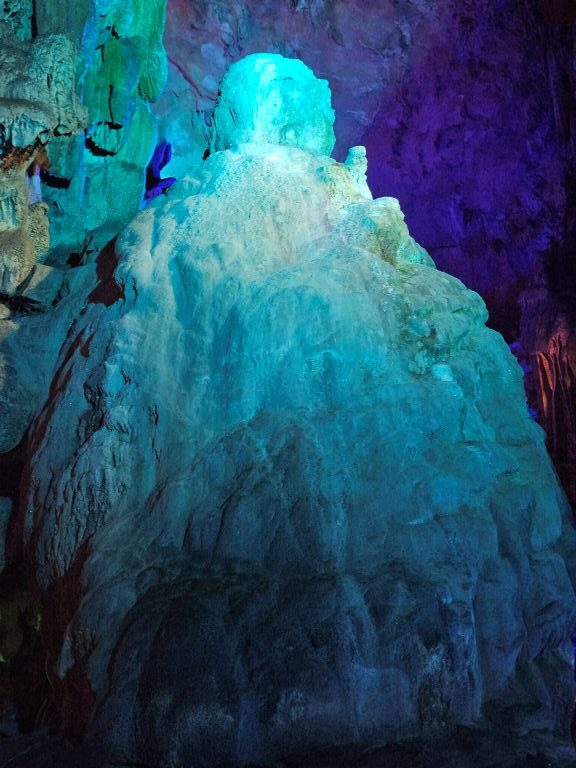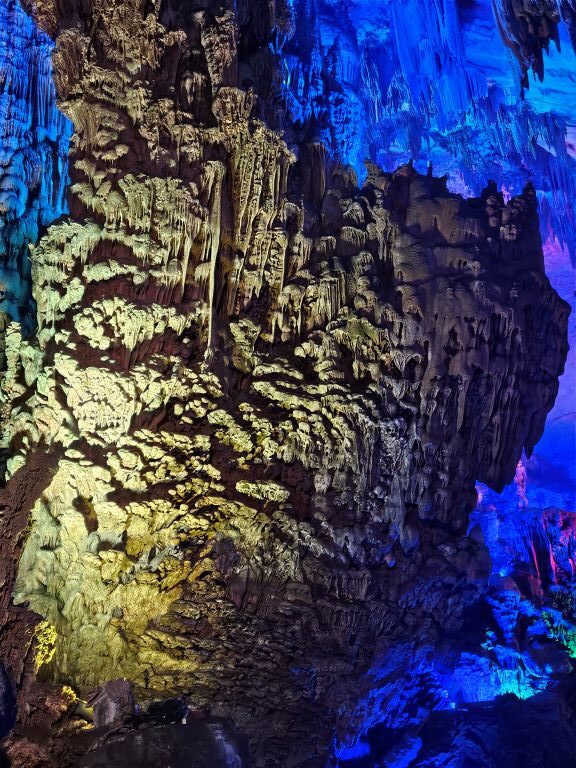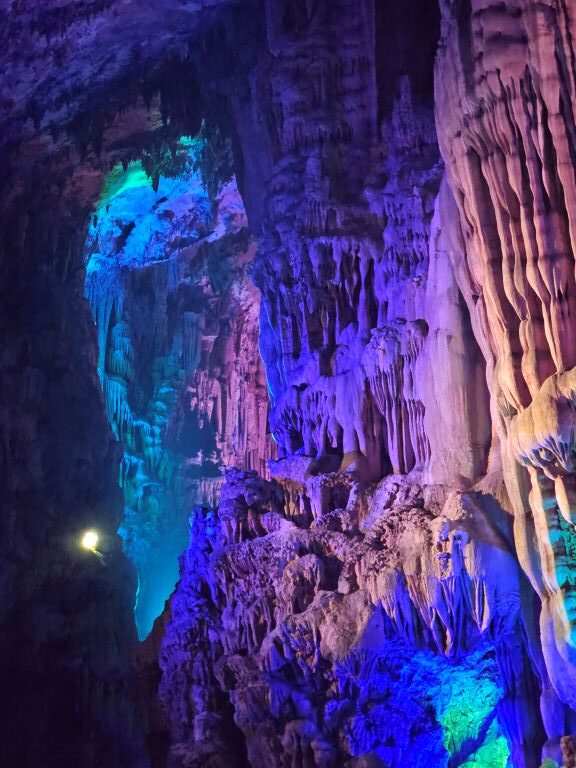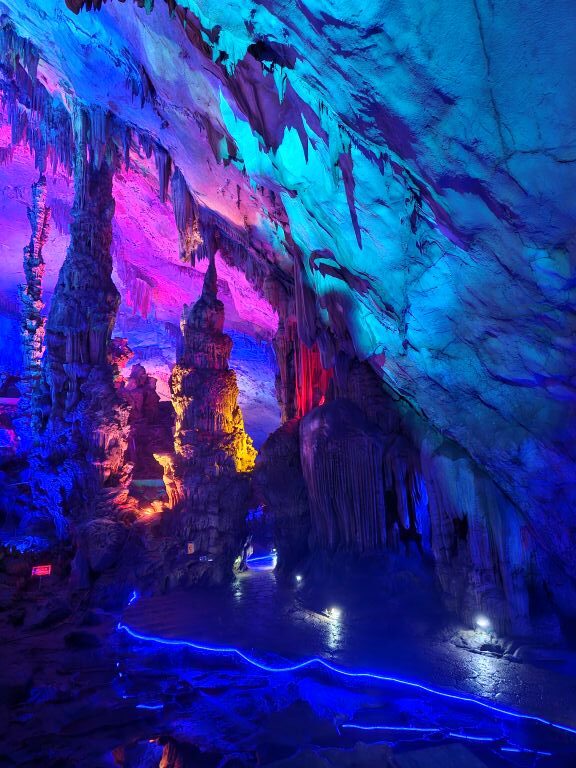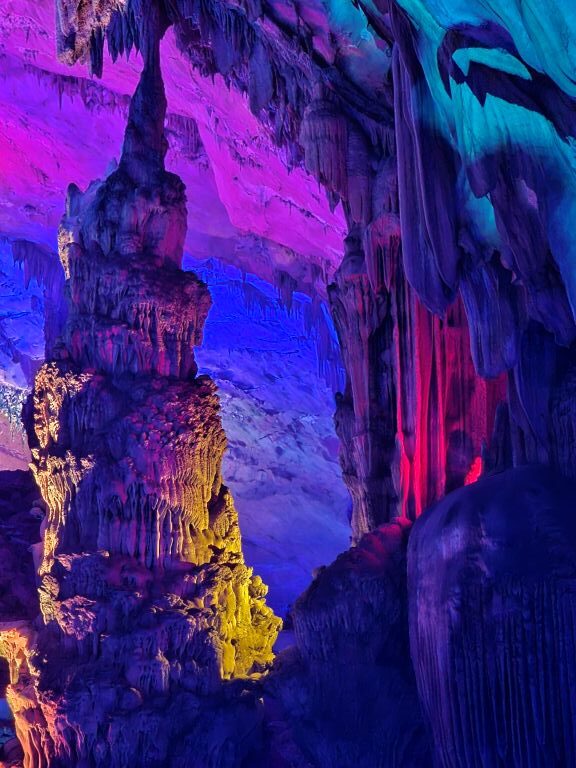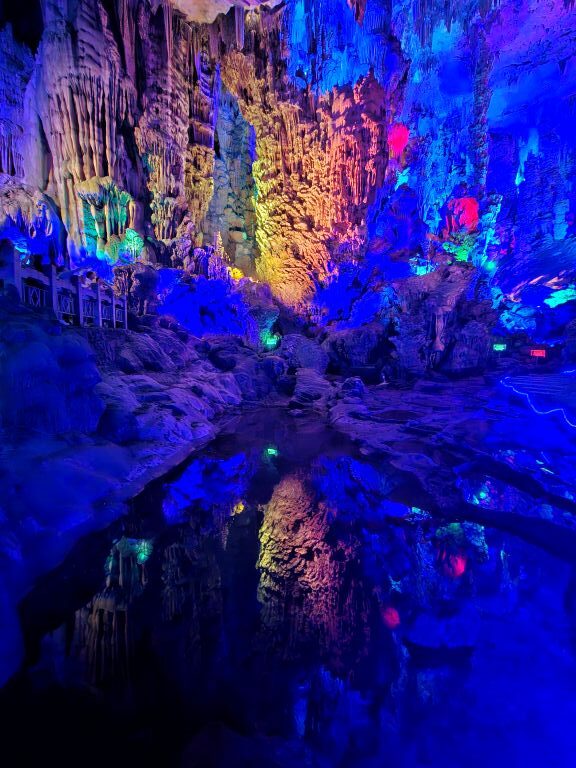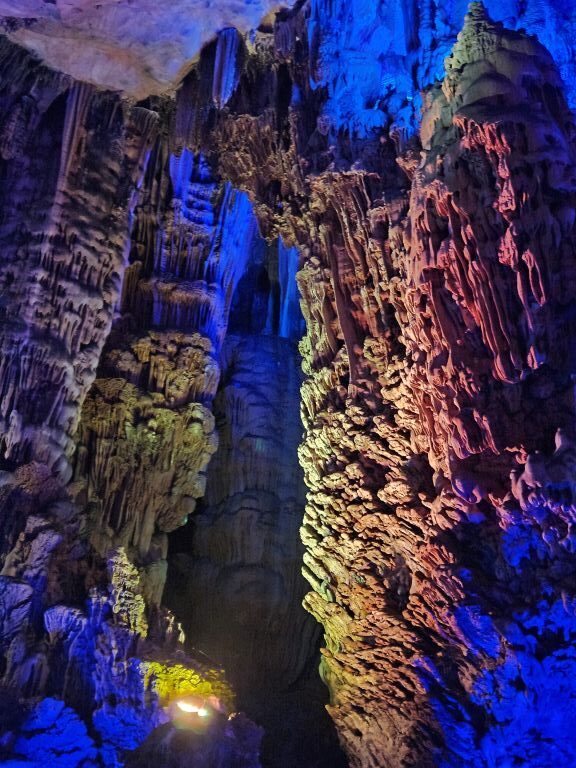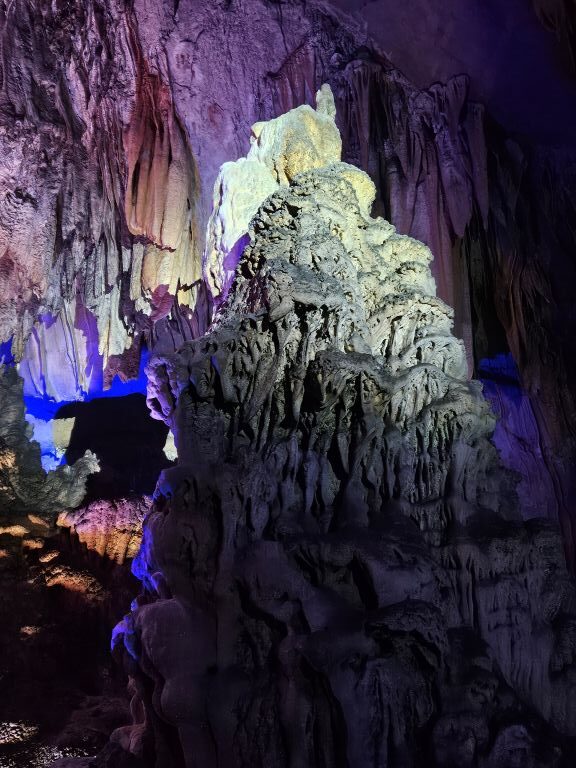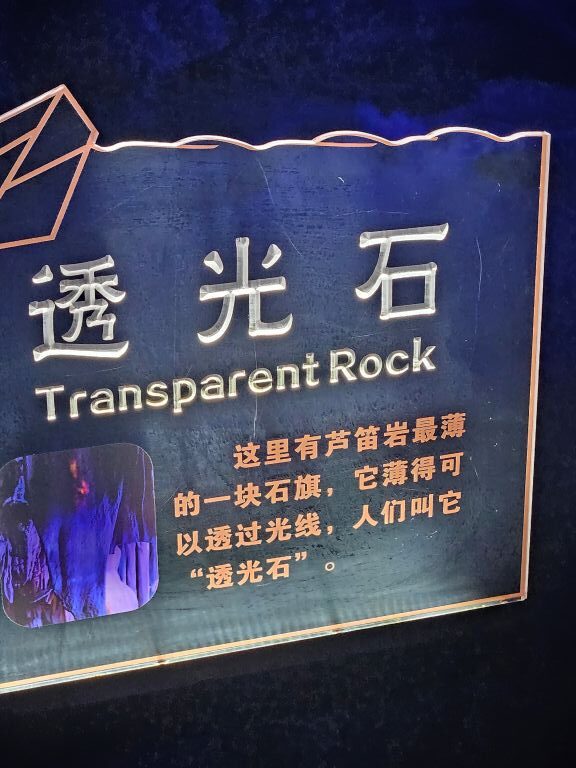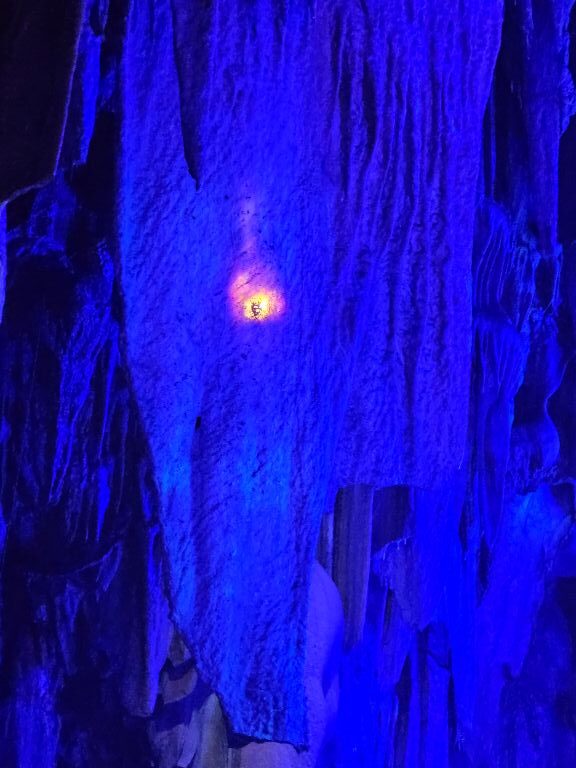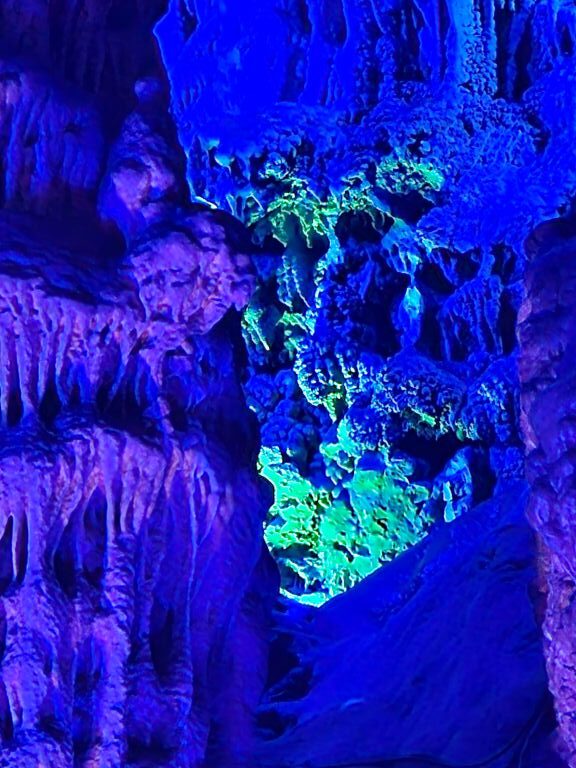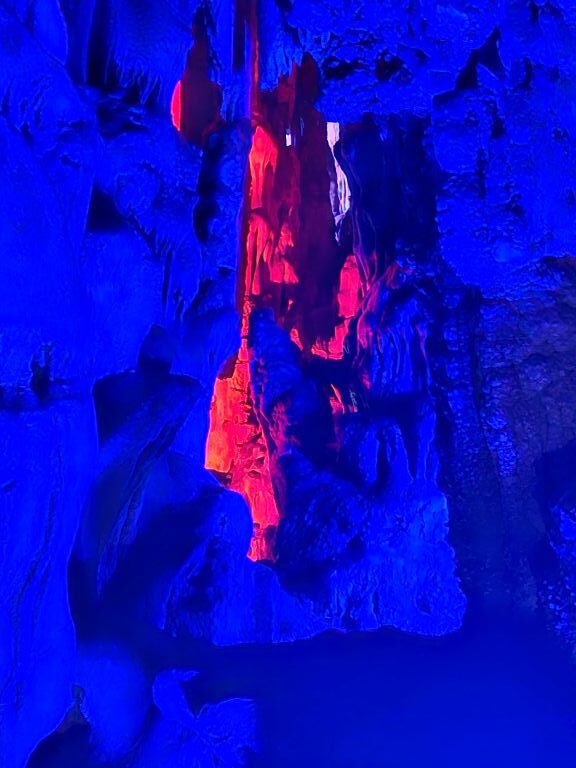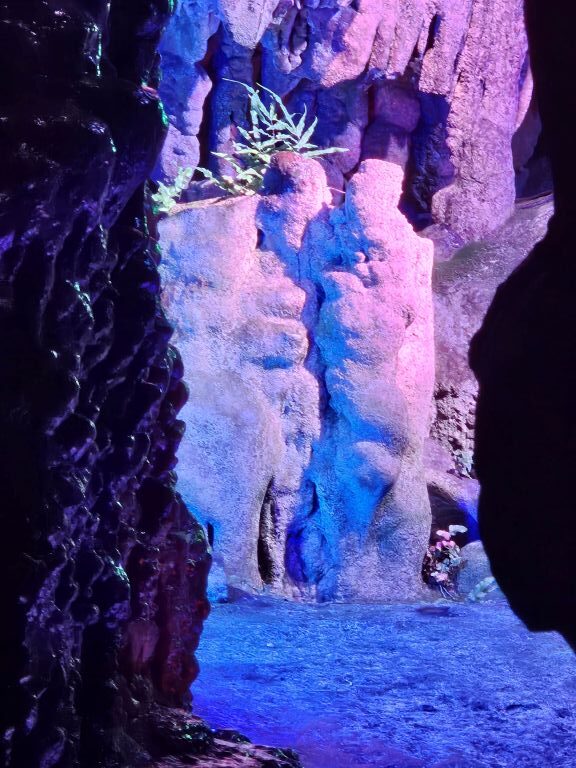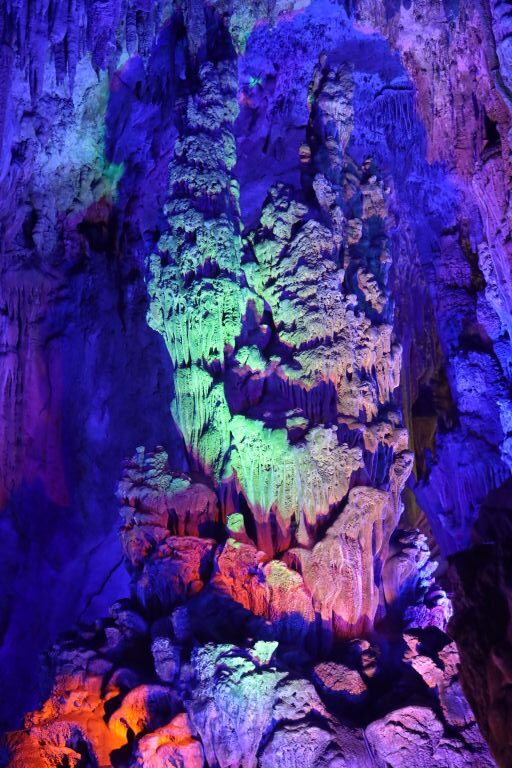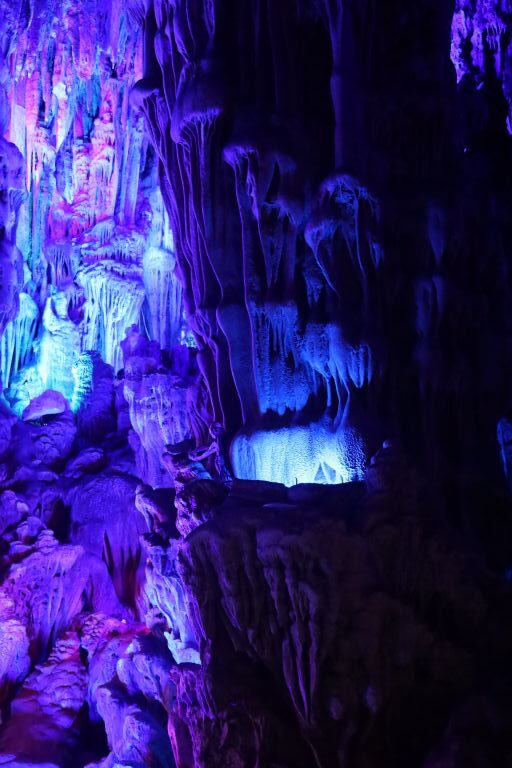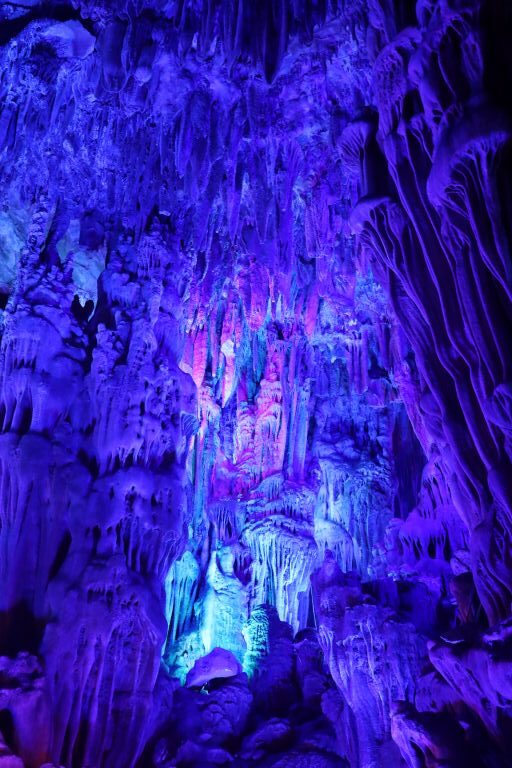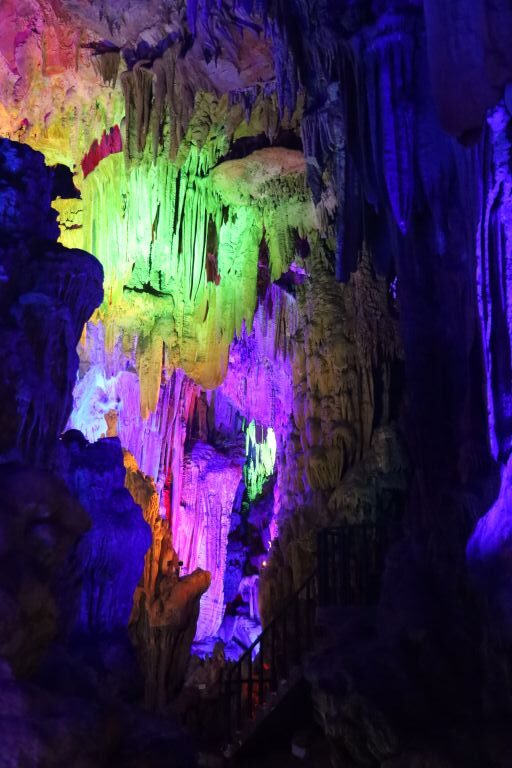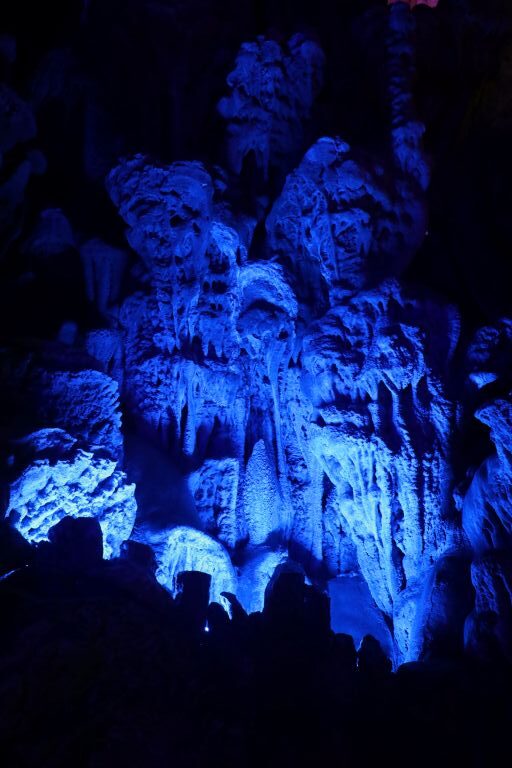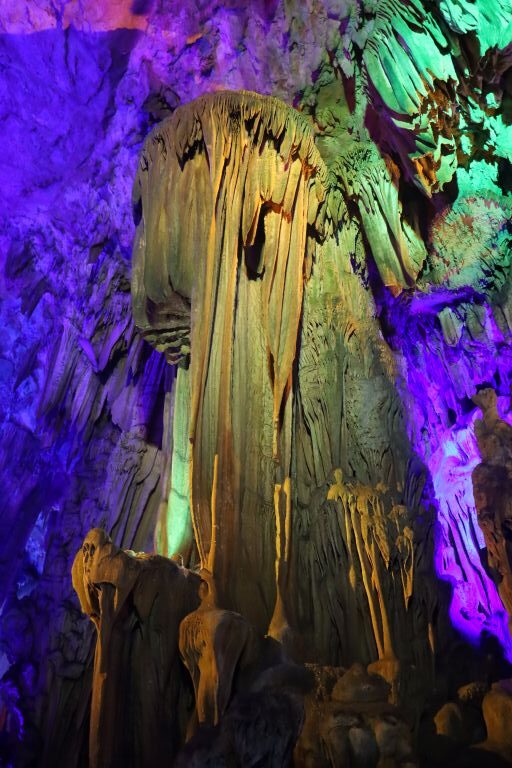25. China/Guanxi: The Reed Flute Cave / Ludi Yan at Guilin
The Wandelgek was driven to the Reed Flute Cave’s entrance, which was in the north west of Guilin.
 The Reed Flute Cave (Chinese: 芦笛岩), also known as “the Palace of Natural Arts”, is a landmark and tourist attraction in Guilin, Guangxi, China.
The Reed Flute Cave (Chinese: 芦笛岩), also known as “the Palace of Natural Arts”, is a landmark and tourist attraction in Guilin, Guangxi, China.
The cave got its name from the type of reed growing outside, which can be made into flutes. Reed Flute Cave is filled with a large number of stalactites, stalagmites and other rock formations. Inside, there are more than 70 inscriptions of poems and travelogues written in ink, the oldest of which can be dated to 792 AD in the Tang dynasty. It was rediscovered in the 1940s by a group of refugees fleeing the Japanese troops.
Nowadays, multicolored lighting artificially illuminates the cave. The Reed Flute Cave is filled with various stalactites and stalagmites, which are named according to what they look like and the legends surrounding them, Crystal Palace, Fish Tail Peak, and Dragon Pagoda. One giant stalactite is said to have been the magic spear of the Dragon King, used by the Monkey King Sun Wukong in the Chinese Buddhist classic, Journey to the West.
More about this Chinese Buddhist classic can be read in my previous blogpost:
19. China/Hunan: The Golden Whip Stream (Walk 3) (Zhangjiajie National Forest Park)
The path into the cave began in silence, broken only by the soft trickle of water echoing through the limestone halls. The rock walls shimmered faintly under the first lights—a cool blue that breathed like twilight. As the group moved deeper, the colors shifted: sapphire to emerald, emerald to violet, an invisible painter brushing the ancient stone with dreams.
My guide Tao said that the distinctive colors seen on specific rocks in Reed Flute Cave are not just a result of artistic lighting, but are also deeply tied to the mineral composition and type of rock present in the cave. These colors originate from different minerals embedded within the limestone, such as iron, copper, and manganese, which were deposited over millions of years as water flowed and dripped through the rock.
For example, iron oxides can give rocks yellow, red, or rusty hues, while copper compounds might add greenish or bluish shades. When water seeps through the limestone, it dissolves and redeposits these minerals along cracks and crevices, resulting in beautiful natural palettes even before any artificial lights are introduced. This natural coloration is then exaggerated and highlighted by the modern LED lighting system that brings out the innate tones of the rocks and formations, making the cave seem even more magical.
Another reason for the colored lights is to “help you see the stories.” In truth, they did more—they reawakened them. The blue light rippled like memory over the stalactites, revealing dragons, goddesses, and towers hidden in the rock’s texture. The red light warmed the air, drawing attention to shapes that looked like a phoenix taking flight. It was as if the cave itself had been waiting centuries for an audience to return.
So, while the modern colored lights help dramatize and reveal each feature, the underlying reason for the cave’s patchwork of colors is geological: different minerals and their reactions during the cave’s slow formation have painted the limestone with their unique tints.
Walking through Reed Flute Cave is more than a passage through limestone; it is a journey into the layered history of nature and culture, where every formation, every ripple on the underground lake’s surface, holds its own story shaped by time, belief, and wonder.
Walking through this wonderful world of color, stones dripping like waterfalls and stones rising like fountains, left The Wandelgek mesmerized and in complete awe …
This could have been what he always imagined that Menegroth would have looked like and other parts resembled the Glittering Caves of Aglarond…
Every turn opened new magnificent views …
… and just as he thought things could not get any more beautiful, walking through another bend in the path just did the opposite and overwhelmed the earlier thoughts, e.g. because a small lake now mirrorred the caleidoscope of colors of the rocks above …
Then there are the Sky-Scraping Twins, two towering stone pillars standing side by side as silent sentinels reaching toward the cave ceiling.
These impressive natural columns were poetically named for their seeming competition to touch the heavens.
Legend tells that these twins are transformed spirits of loyal brothers, turned to stone as guardians of the cave, symbolizing unbreakable bonds and eternal watchfulness.
The moonlike globe beneath was fascinating. Was it a stalagtite or was it a prop put there by the cave’s management?
The dark rocks in front looked a bit like people gathering and looking up to the moon …
In the photo beneath someone is actually pointing at the moon …
Stalactites form when mineral-rich water (usually containing dissolved calcium carbonate from limestone) seeps through the cracks in a cave ceiling. As each drop hangs, carbon dioxide escapes, causing calcite to precipitate out and accumulate, growing downward like an icicle from the ceiling. The process continues as more mineral-laden water drips, often taking thousands of years to develop noticeable formations. Stalactite formation is favored by a slower drip rate, which allows for greater mineral deposition before the drop falls.
Stalagmites develop directly beneath stalactites, on the cave floor. When drops carrying dissolved minerals fall and hit the ground, they deposit some remaining minerals, which build up over time to create a mound or cone rising upward. Stalagmites tend to grow higher when the drip rate is faster, because more minerals make it to the ground before being deposited.
Over long periods, stalactites and stalagmites may eventually meet and fuse, forming a column or pillar, enriching the cave’s geological architecture.
There were of course the large stalactites, but the more carefully The Wandelgek looked, tge more he observed tge tiny stalactites which looked like mushrooms growing from the ceiling…
Then came the lake. The Crystal Palace is the widest and one of the most spectacular chambers inside Reed Flute Cave. It measures about 93 meters wide and 18 meters tall, a grand hall where stalactites hang in all directions like a series of glowing lanterns. Under colorful lighting, some stalagmites even look like jumping fish, creating a dazzling natural spectacle that evokes the feeling of entering a magical palace.
It lay utterly still, a mirror doubling the world in perfect symmetry …
As you step further into the radiant halls of Reed Flute Cave, the magic of this “Nature’s Art Palace” envelops you not only through vivid colors but through stories carved in stone and whispered by ancient waters…
The cave, formed over hundreds of thousands of years from an ancient underground lake, still carries the silent pulse of that water, visible in the calm, reflective underground lake. This lake is said to be the soul of the cave—a mirror to both the natural world above and the secret worlds beneath.
Above I’m pointing at what is called the “Beautiful reflection of Snow Mountain”. It really gets your imagination going haywire.
Ancient visitors believed the lake held sacred energy, a sacred reservoir sustaining the cave’s life-giving light and crystalline growth.
The ceiling’s spikes hung above and below, like fangs reflected in glass …
Among the dazzling stone formations, you find the Crystal Palace of the Dragon King, a cathedral-like chamber of gleaming stalactites and stalagmites so intricate and vast that early visitors named it a home for celestial beings.
This palace held a special place in local lore, thought to be the dwelling of the Dragon King, protector of water and weather. It is said that during ancient floods and droughts, prayers to the Dragon King echoed within these walls, seeking balance between earth and sky.
When someone dropped a pebble, the ripples danced with rainbow fire …
Tao my guide whispered that the lake was once thought to be a gateway to the sky—water above, earth below, light connecting both. Standing before it, that myth didn’t feel far away.
 The Monkey King’s Golden Cudgel (photo beneath shows its reflection in the mirror lake) is known as a prominent stalactite shaped like a staff, associated with the legendary magic weapon of Sun Wukong from Chinese folklore.
The Monkey King’s Golden Cudgel (photo beneath shows its reflection in the mirror lake) is known as a prominent stalactite shaped like a staff, associated with the legendary magic weapon of Sun Wukong from Chinese folklore.
 According to legend, one giant stalactite within Reed Flute Cave is said to be the magic spear originally wielded by the Dragon King, which later the Monkey King used in his adventures. This stalactite is not only a stunning natural formation but is culturally infused with mythic significance, symbolizing the Monkey King’s power and his legendary battles. Stories say that this weapon was involved in epic fights against the Dragon King’s underlings, and its presence within the cave connects it to the timeless narrative of heroism and magic from Chinese folklore.
According to legend, one giant stalactite within Reed Flute Cave is said to be the magic spear originally wielded by the Dragon King, which later the Monkey King used in his adventures. This stalactite is not only a stunning natural formation but is culturally infused with mythic significance, symbolizing the Monkey King’s power and his legendary battles. Stories say that this weapon was involved in epic fights against the Dragon King’s underlings, and its presence within the cave connects it to the timeless narrative of heroism and magic from Chinese folklore.
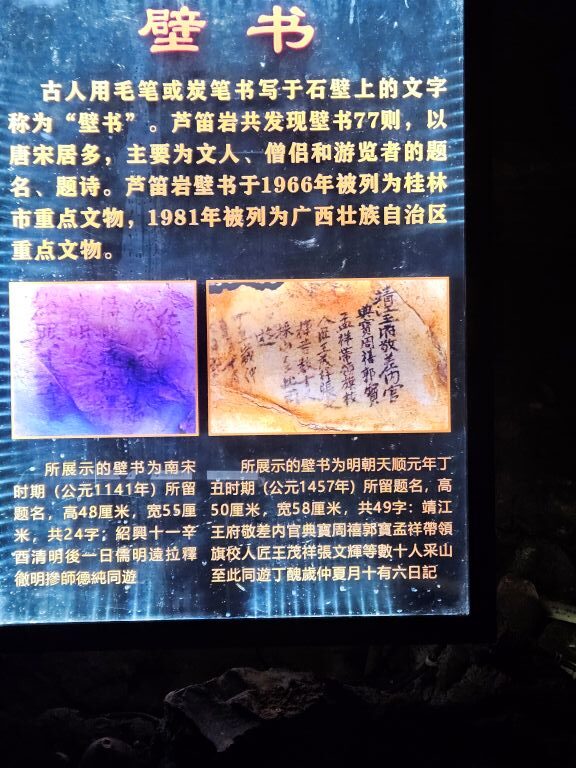 At one wall, an inscription shimmered faintly in the colored glow—poems carved by travelers a thousand years ago. The characters, worn but graceful, sang of longing, of journeys, of the endless companionship between humans and mountains. One line spoke of “a flute’s song calling clouds home,” and suddenly the cave’s name felt less like geology and more like music—one born from stone, light, and time.
At one wall, an inscription shimmered faintly in the colored glow—poems carved by travelers a thousand years ago. The characters, worn but graceful, sang of longing, of journeys, of the endless companionship between humans and mountains. One line spoke of “a flute’s song calling clouds home,” and suddenly the cave’s name felt less like geology and more like music—one born from stone, light, and time.
They said the poets who carved their verses into stone never truly left. Their words shimmered faintly when the moonlight touched the limestone mouth of the Reed Flute Cave, as if memory itself had become phosphorescent…
The first of them, it was told, was a wanderer from the Tang court. Exiled for speaking too boldly, he carried only a bamboo flute and a hunger for beauty. One evening, seeking shelter from the monsoon, he discovered the cave’s entrance veiled by reeds that whispered as the wind passed through them. Inside, he lit a lantern and saw the world reborn — crystal spires that hung like frozen rain, pools that mirrored galaxies. Overwhelmed, he inscribed a poem upon the nearest wall, a hymn to light and loss. When he lifted his flute, the cave answered in a chorus of echoes so pure that the stone itself seemed to sigh.
In this poem, a voice rises from the depths, telling of an ancient guardian—the Rainbow Serpent—whose scales shimmer with a thousand colors, weaving life’s creation and protection. It is one among many spirits, a protector watching over land and people, a mother of sacred origins.
 One central symbolic element in many of these poems is the Rainbow Serpent, a figure drawing from Indigenous Australian Dreamtime mythology, representing creation, spiritual protection, and the interconnectedness of all life. One of The Wandelgek’s favorite books of all time is Marlo Morgan’s “Mutant’s message downunder” which was translated into ditch carrying this title: “Australië op blote voeten“, which translates as “Barefoot through Australia”. It is a wonderful book about Aboriginal life in Australia seen through the eyes of a western guest. My favorite chapter translates as: “Dreamcatcher” and here it is that the Aboriginal concept of dreamtime is explained best.
One central symbolic element in many of these poems is the Rainbow Serpent, a figure drawing from Indigenous Australian Dreamtime mythology, representing creation, spiritual protection, and the interconnectedness of all life. One of The Wandelgek’s favorite books of all time is Marlo Morgan’s “Mutant’s message downunder” which was translated into ditch carrying this title: “Australië op blote voeten“, which translates as “Barefoot through Australia”. It is a wonderful book about Aboriginal life in Australia seen through the eyes of a western guest. My favorite chapter translates as: “Dreamcatcher” and here it is that the Aboriginal concept of dreamtime is explained best.
Centuries later, during the Ming wars, a soldier found the same cave chamber. Fleeing pursuit, he hid among the stalactites and found the Tang poet’s verse. Thinking it a message from heaven, he added his own lines beside it: a vow of peace, written not for kings but for the earth that outlasts them. When his blood fell upon the stone, the cave glowed again, sealing both oaths in its crystal heart.
Another poem whispers of homesickness and memory, of cool waters that serve as mirrors reflecting distant seas and mudflats. These waters call the traveler’s spirit, awakening the ache for home and roots that stretch beneath foreign skies, reminding that the soul’s song endures beyond this place.
The last poem, the guides now say, appeared in the age of lanterns and paper maps. An artist—perhaps a woman disguised as a scholar—wandered from Guilin’s gardens into the cave’s depths, sketching shapes that danced in her lamplight. She wrote only a few lines, a prayer to the dragon beneath the mountain to guard the songs of humankind. When she left, so the tale goes, the stalactites took her words into their slow, living growth, weaving them into the mineral veins.
In final hopes, a prayer ascends—a plea for protection from shadow and darkness, a balance between earth and sky. It is a hymn of resilience and faith, turning stone and silence into sanctuary, where the ancient spirit and mortal heart find common ground.
Reflection deepens as the sacred waters reveal faces of ancestors and paths long traveled. They hold timeless truths, binding the self to the earth’s great web, a sacred covenant to honor the interwoven life surrounding all beings.
Visitors who pause in silence sometimes swear they can still hear it: an echo like distant chanting, where the wind moving through the cave mouths recites those three poems at once, blending sorrow, courage, and wonder into a single endless breath.
The transparent rock formations in Reed Flute Cave are primarily composed of calcite crystals, a mineral form of calcium carbonate. These calcite formations often appear translucent or even glass-like due to the purity and crystalline nature of the mineral deposits.
Calcite crystals form as mineral-rich water drips inside the limestone cave, and as carbon dioxide escapes, calcium carbonate precipitates and slowly accumulates into spectacular crystal formations. This crystalline quality is particularly prominent in formations sometimes called the “crystal palace” or crystal curtains within the cave, where the lighting enhances their translucent, shimmering effect.
These dazzling, translucent spaces are natural limestone and calcite sculptures shaped over millions of years by water erosion, mineral deposition, and the slow dance of geology and time—all enhanced by colorful cave lighting that makes them appear almost otherworldly.
The sparkling transparent or translucent calcite crystal formations in Reed Flute Cave, are what create the cave’s magical and ethereal atmosphere.
And etereal it is …
This rock formation was called: The Stage Curtain. It refers to a stunning, large, naturally occurring formation that resembles a flowing curtain on a theater stage which when it opens is the start of a wonderful show. These formations are a type of calcite curtain or cave curtain hanging from the ceiling or wall of the cave, formed by mineral-rich water flowing along inclined or sloped surfaces, gradually depositing calcium carbonate in a sheet-like fashion.This natural “stage curtain” appears as a smooth, flowing sheet of translucent stone, often with gentle ripples or undulations, creating the impression of a velvet or silk curtain suspended in mid-air. When illuminated with the cave’s colorful lighting, these formations shimmer and seem to ripple like fabric in the breeze, adding to the cave’s enchanting atmosphere.
In Reed Flute Cave, a curtain (also called a “drapery” or “cave curtain”) in general is a type of speleothem formation that resembles a thin, wavy sheet or hanging cloth of calcite. These formations (there are more of them inside thos cave) are created when mineral-rich water flows along an inclined surface of the cave wall or ceiling, depositing calcium carbonate in thin sheets rather than in droplet-like stalactites.
This curtain-like rock often appears translucent or semi-transparent, sometimes shimmering under cave lighting, which enhances its delicate, flowing appearance. The curtain’s folds and undulations look like fabric hanging in gentle waves, adding to the cave’s magical beauty.
Geologically, curtains form over time from slowly dripping or flowing water that leaves calcite deposits along a slanting ceiling or wall route. They differ from stalactites which grow more vertically downward in icicle shapes.
The stone waterfalls or cascades in Reed Flute Cave are natural formations that resemble flowing waterfalls frozen in time. These formations are created by the continuous deposition of calcium carbonate from dripping water over millions of years.
The most striking “waterfall” feature resembles a giant cascade of smooth stone, where mineral-laden water has flowed down inclined surfaces, leaving behind limestone that forms a smooth, flowing sheet of rock — almost like a frozen curtain or giant waterfall suspended in mid-air.
This particular formation looks as though water has been pouring down in a relentless stream, but it’s actually a slow process of mineral crystallization. The ongoing drip of mineral water continues to feed and shape these cascade-like structures, making them appear dynamic and alive, even though they are inert stone now.
This natural sculpture is an example of how water erosion and mineral deposition over vast lengths of time can produce spectacular, waterfall-like formations entirely made from rock—testaments to nature’s artistry and patience.
The next part was again what I imagined Tolkien’s Menegroth to be like…
A vivid description from Tolkien about Menegroth is found in the “Lay of Leithian” and other sources describing the Thousand Caves of Menegroth:
“It was a great chamber with vaults made of stone sculpted as tree trunks, and they appear like magical trees thriving eternally. Its treetops were unending twists and turns of shimmering leaves that keep the light of the sun and moon, with jewels on them and stems made of gold. Fountains of water flow throughout the stone ground, while perpetual blossoms fill the place and nightingales linger in the arbor, singing over Melian. There lies the throne room of Thingol, and the King wore a silver and green crown.”
By J.R.R. Tolkien
Publication Details:
- Book: The Silmarillion
- Author: J.R.R. Tolkien
- Editor: Christopher Tolkien
- Publisher: George Allen & Unwin (UK), Houghton Mifflin (US)
- Publication Year: 1977 (first edition)
- Additional source for poetic form: The Lays of Beleriand (published 1985), edited by Christopher Tolkien
Menegroth is renowned as the secret city-fortress of the Sindar Elves of Doriath, carved into the rocks by the Dwarves of Belegost and Belegost. The halls were shaped with great artistry to resemble an enchanted wood—columns and vaults carved so intricately that stone took the form of trees and plants, capturing the beauty of a living forest in solid rock.The craftsmanship made the cave appear like a natural palace of stone trees that thrived forever, with flowing water and jeweled leaves reflecting eternal light—an eternal fusion of natural wonder and elven artistry inspired by the love of forests.This beautifully captured imagery emphasizes how the dwarves’ technical skill transformed the cave interior into a hall of magical stone trees and plants, a grand natural-architectural marvel deeply embedded in Tolkien’s mythic landscape.
Menegroth is renowned as the secret city-fortress of the Sindar Elves of Doriath, carved into the rocks by the Dwarves of Belegost and Belegost.
The halls were shaped with great artistry to resemble an enchanted wood—columns and vaults carved so intricately that stone took the form of trees and plants, capturing the beauty of a living forest in solid rock.
The craftsmanship made the cave appear like a natural palace of stone trees that thrived forever, with flowing water and jeweled leaves reflecting eternal light—an eternal fusion of natural wonder and elven artistry inspired by the love of forests.
This beautifully captured imagery emphasizes how the dwarves’ technical skill transformed the cave interior into a hall of magical stone trees and plants, a grand natural-architectural marvel deeply embedded in Tolkien’s mythic landscape.
As a huge Tolkien fan and collector, I had to describe how I felt while walking through these caves, using the citation of Menegroth’s interior, because the Reed flute cave really felt like strolling through the book pages …
When the lights dimmed to their final hue—a soft amber that felt almost like candlelight—the cave no longer seemed underground. It felt like being inside the Earth’s heartbeat, where color, water, and poetry all spoke the same language …
After leaving the cave, our chauffeur picked Tao and me up and we returned to my hotel. We agreed upon a pick up time for later that evening, but I first went up to my room for a shower and a short nap.
Read more about my upcoming adventures in my next blogpost about my stay in Guilin.


